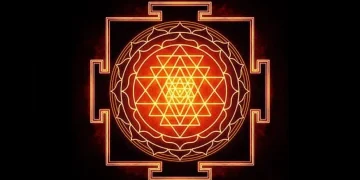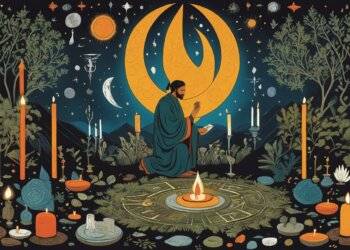“Who looks outside, dreams; who looks inside, awakes.” – Carl Jung’s timeless words capture the essence of gnosis, a transformative pursuit of self-knowledge that has shaped seekers for over 2,000 years. This ancient Greek concept, meaning “knowledge” (γνῶσις), transcends intellectual facts. It represents direct insight into your true nature – a spark of divinity hidden beneath life’s distractions.
Unlike ordinary learning, gnosis isn’t about memorizing ideas. It’s an experiential journey where wisdom emerges through self-reflection and conscious living. Rooted in Hellenistic traditions, this path empowers you to question inherited beliefs and discover truths that resonate with your deepest self.
Modern seekers use gnosis as a bridge between logic and intuition. It offers tools to decode life’s patterns while honoring mysteries that defy explanation. This living practice helps dissolve the illusion of separation – between mind and spirit, past and present, you and the world.
Key Takeaways
- Gnosis combines ancient wisdom with actionable strategies for personal growth
- True understanding comes from direct experience, not theoretical study
- This practice encourages self-guided exploration over rigid dogma
- Balances analytical thinking with intuitive awareness
- Offers timeless methods relevant to modern life challenges
As you continue through this main article, you’ll discover how spiritual knowledge becomes practical wisdom. Learn to recognize gnosis in daily moments – from creative breakthroughs to quiet realizations – and transform how you approach relationships, purpose, and growth.
Introduction to Gnosis
True understanding begins where textbooks end. The Greek word “gnosis” carries a revolutionary meaning – it’s not about collecting facts, but awakening to truths written in your bones. Like the French connaître versus savoir, this concept reveals the difference between textbook learning and lived wisdom.

Imagine knowing fire intellectually versus feeling its warmth. Gnosis works similarly – it’s knowledge etched through experience, not borrowed from others. Ancient thinkers designed this path for those seeking answers beyond surface-level explanations.
Modern life bombards us with information. But gnosis offers a compass for navigating noise. It blends logic with intuition, helping you recognize patterns in challenges while honoring life’s mysteries. This approach transforms abstract ideas into personal breakthroughs.
Languages worldwide echo this distinction. Spanish speakers use conocer for intimate understanding, while Germans choose kennen over wissen. These linguistic mirrors show our universal need for embodied knowledge that shapes decisions and values.
This article explores how ancient wisdom becomes modern toolkit. You’ll discover methods to bridge head and heart, turning daily moments into portals for self-discovery. The journey starts here – where knowing becomes being.
Defining Gnosis in Spiritual and Esoteric Terms
What if true understanding required no textbooks or teachers? Across traditions, a radical form of awareness emerges – not learned, but awakened through direct experience. This spiritual knowledge bypasses rituals and doctrines, connecting you to truths that reshape how you perceive reality.

The Living Essence of Esoteric Understanding
Unlike religious teachings passed through institutions, esoteric knowledge flows from personal encounters with the sacred. Think of it as wisdom written in light rather than ink – revealed through moments of clarity that defy logical explanation. Ancient mystics compared this process to remembering something you’ve always known but forgot.
This transformative awareness operates on three levels:
- Intuitive resonance: Recognizing truths that align with your deepest self
- Embodied realization: Feeling wisdom in your bones rather than just your mind
- Practical integration: Applying insights to daily challenges and relationships
Modern psychology echoes this approach. Carl Jung’s concept of individuation mirrors the gnostic journey – both involve integrating hidden aspects of self to achieve wholeness. When spiritual knowledge becomes lived experience, you stop seeking answers and start embodying them.
The power lies in its immediacy. You don’t need special qualifications to access this wisdom, only the courage to trust your inner compass. As Plotinus taught, “Knowledge has three degrees – opinion, science, illumination.” The final stage arrives when knowing and being become one.
Etymology and Linguistic Roots of Gnosis
The story of gnosis begins not in temples but in everyday Greek conversations about skill and understanding. This ancient noun traveled through centuries, gathering layers of meaning like a river collecting tributaries.

Greek Origins and Meaning
In Classical Greece, gnosis simply meant “knowledge gained through experience.” Think of a potter knowing clay by touch rather than theory. The related term gnostikos described practical cognitive abilities – the kind of sharp intuition that helps leaders make quick decisions.
Plato used these words without mystical connotations. For him, they represented cultivated talents like a musician’s ear or a general’s strategic vision. This secular foundation would later support profound spiritual developments.
Evolution in Religious Contexts
Hellenistic mystery cults transformed the term’s meaning like alchemists turning lead to gold. Suddenly, knowledge meant direct communion with divine forces rather than earthly expertise. The word became a bridge between human and cosmic understanding.
This shift created new pathways for seekers. Where philosophers debated ideas, initiates pursued embodied wisdom – tasting truth rather than describing it. The linguistic evolution mirrors humanity’s growing hunger for transcendent experiences.
The Role of Gnosis in Gnosticism
Imagine unlocking salvation not through rituals or creeds, but through a personal revelation that rewires your understanding of reality. This radical idea fueled Gnostic movements emerging in the late 1st century CE, where secret knowledge became the key to spiritual liberation.

Spiritual Knowledge vs. Institutional Faith
Gnostic teachings proposed a daring alternative to mainstream religion. They positioned direct experience as the ultimate path to enlightenment, empowering individuals to bypass traditional gatekeepers. Unlike faith-based systems requiring adherence to doctrines, these groups taught that inner awakening could dissolve illusions binding humanity to the material world.
Three revolutionary principles defined this approach:
- Salvation through self-realization rather than external approval
- Mentorship models preserving wisdom through close teacher-student bonds
- Critical examination of organized religion’s role in spiritual growth
Modern seekers recognize this tension between personal truth and collective belief systems. The Gnostic emphasis on individual revelation mirrors today’s growing preference for self-directed spirituality over rigid institutional frameworks.
By studying these ancient rebels, you gain tools to navigate contemporary spiritual landscapes. Their legacy shows how personal insight can coexist with – or challenge – established traditions, offering timeless strategies for authentic self-discovery.
Historical Context and Origins of Gnostic Thought

Alexandria’s bustling markets and libraries became the unexpected birthplace of revolutionary spiritual ideas. This Mediterranean crossroads mixed Egyptian rituals, Greek philosophy, and Jewish mysticism – creating fertile soil for new understandings of divine knowledge.
Middle Platonism’s theory of forms deeply shaped early Gnostic thought. Philosophers like Philo of Alexandria bridged Plato’s abstract ideals with practical spirituality, asking: “What if truth lives not in temples, but in the seeker’s mind?” This fusion birthed a unique approach to enlightenment through self-examination.
Three key influences converged in early Christian communities:
| Tradition | Contribution | Modern Parallel |
|---|---|---|
| Judaic Apocalypticism | Symbolic visions of transformation | Vision board practices |
| Greek Philosophy | Logical truth-seeking frameworks | Cognitive behavioral techniques |
| Mystery Religions | Experiential initiation rituals | Retreat-based self-discovery |
The diversity of early Christianity becomes clear when examining Alexandria’s ecclesia. Jewish-Christian roots blended with Greek converts’ perspectives, creating space for radical reinterpretations of faith. As Clement of Alexandria noted:
“Truth hides in plain sight, waiting for those who dare to see differently.”
This historical lens shows how spiritual breakthroughs emerge through cultural exchange. By studying these origins, you gain permission to blend traditions in your own growth journey – mixing ancient wisdom with modern insights for personal transformation.
Gnosis in Early Christianity
Paul’s letters to early Christian communities crackle with references to transformative knowledge – the New Testament uses gnōsis 28 times. This spiritual understanding became a bridge between divine revelation and daily living. Early believers saw it as fuel for ethical choices, not just abstract theology.

Patristic Interpretations
The early church fathers shaped spiritual knowledge into practical wisdom. Clement of Alexandria taught that true gnosis worked with conscience (syneidesis) like two oars steering a boat. This blend of insight and moral clarity helped believers:
- Discern truth beyond surface appearances
- Align actions with inner convictions
- Navigate complex social challenges
The Influence of Early Christian Sects
Diverse interpretations of spiritual knowledge sparked rich debates. Mainstream Christianity absorbed insights from various groups while establishing doctrinal boundaries:
| Group | Key Contribution | Modern Impact |
|---|---|---|
| Marcionites | Distinct Old/New Testament views | Interfaith dialogue models |
| Valentinians | Allegorical scripture reading | Mystical tradition revival |
| Ebionites | Ethical living focus | Social justice movements |
These historical tensions reveal a truth for modern seekers: spiritual growth often happens through wrestling with different perspectives. As Irenaeus noted,
“Truth emerges when error sits at the table of discussion.”
Jewish and Hellenistic Influences on Gnosis
Ancient mystical practices often hold keys to modern self-discovery. The blend of Jewish visionary traditions and Greek philosophy created a crucible for transformative spiritual insights. This fusion shows how wisdom evolves through cultural exchange – offering timeless tools for those seeking deeper understanding.
Visionary Roots in Mystical Traditions
Merkabah mysticism’s chariot visions became blueprints for transcendent experiences. These early Jewish practices focused on divine encounters through meditation and sacred geometry. Scholars like Gershom Scholem found striking parallels between these methods and later gnostic techniques for accessing hidden knowledge.
The Maaseh Breshit (Work of Creation) and Maaseh Merkabah (Work of the Chariot) texts reveal practical frameworks still relevant today. They teach pattern recognition in chaos – seeing cosmic order in personal challenges. Modern seekers can adapt these approaches to decode life’s symbolic messages.
Nag Hammadi manuscripts demonstrate this living legacy. Some texts reinterpret Hebrew stories while others create new mythologies. This tension between tradition and innovation mirrors contemporary spiritual exploration – honoring ancient wisdom while forging personal paths.
By studying these intersections of religions and philosophies, you gain tools to bridge ancient texts and modern dilemmas. The real magic happens when esoteric knowledge becomes practical wisdom – turning visionary insights into daily transformation.
FAQ
How does spiritual knowledge differ from ordinary learning?
Spiritual knowledge focuses on direct, transformative insight into divine truths—often through introspection or mystical experiences—rather than intellectual study. It emphasizes self-realization and liberation from limiting beliefs, aligning with ancient traditions like Gnosticism that prioritized inner awakening.
What linguistic roots shaped the concept of gnosis?
The term originates from the Greek gnōsis, meaning “knowledge” or “awareness.” Over time, it evolved in religious contexts to signify sacred wisdom—particularly in Hellenistic Jewish texts and early Christian sects—where it represented a path to salvation beyond dogma.
Why did Gnosticism challenge institutional faith systems?
Gnostic traditions viewed spiritual knowledge as a direct connection to the divine, contrasting with structured rituals or hierarchical authority. Teachings often framed the material world as flawed, urging followers to seek enlightenment through personal revelation rather than external doctrines.
How did early Christian leaders respond to gnostic ideas?
Figures like Irenaeus and Tertullian criticized gnostic groups as heretical, arguing their esoteric teachings conflicted with orthodox doctrines. This tension highlighted debates about salvation—whether achieved through faith alone or inner illumination—that shaped Christianity’s evolution.
What role did Jewish mysticism play in gnostic thought?
Practices like Merkabah mysticism—which focused on visionary ascents to divine realms—influenced gnostic cosmology. These traditions shared an emphasis on secret wisdom and transcending physical reality, blending with Hellenistic philosophy to shape early esoteric movements.
Can modern seekers apply gnostic principles today?
Absolutely. The pursuit of self-discovery through introspection, questioning superficial narratives, and seeking transformative truths remains relevant. By integrating these principles, you cultivate resilience and clarity—cornerstones of personal and professional growth.




























































